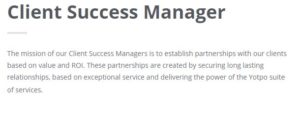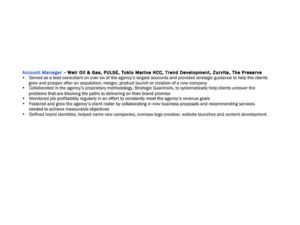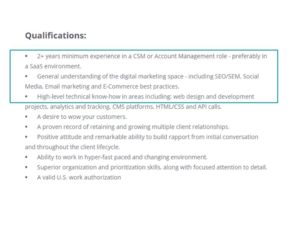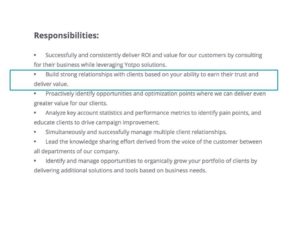
“I want to do something different, but I don’t want to start over.”
Does that sound familiar? Why do we assume A (doing something different) means B (starting over)?
We’ve seen and heard many examples where A does equal B. A good friend transitioned from corporate to freelance and struggled to make ends meet for two years. Or, a family member once in finance moved over to marketing and had to take an entry level role.
These situations happen because there is always a give and take. What are you sacrificing to achieve what you want?
But, immediately assuming A=B holds us back from exploring and creating a new solution, the non-obvious solution and the one that’s likely better suited for us.
Can we explore what’s possible, and come up with a new option? Here’s how to move through a transition and create the best possible outcome.
How to Do Something Different
1. Get Clear on Your Goal
What are you trying to achieve long-term and immediately? Our goal is our anchor. It grounds us and keeps us focused.
For example, if you’re making a career transition, are you striving to be an executive at a large media company, or do you want to run your own startup?
If you don’t have a sense of your long-term goal, what’s the short-term outcome you desire? Is it more money, and a challenging role? Or, are you looking to gain a new skill set?
Separate the two so you can start organizing the opportunities you’re exploring.
2. Identify the Must-Haves
What’s nonnegotiable, and how does your experience measure up? This should give you a sense of how much effort you’ll need to exert to accomplish your goal.
For example, Abby, a student in the Work Bigger pilot, quit her advertising job in Texas and moved to New York City to pursue a new career. Although Abby’s still working through her mission (long-term goal), she knows she wants to diversity her skills.
Therefore, she’s applying for client success manager roles at various technology companies like Facebook and Yotpo.
However, although Abby is looking to transition to a technology company, she doesn’t have technology experience.
But before we resign to “This is going to be so challenging,” let’s dig deeper. Here’s a snapshot of the job role Abby is seeking.
The nonnegotiable is clear: The candidate must be capable of building long-term, sustainable relationships that drive results for the company.
To make this transition, Abby has to successfully demonstrate her ability to deliver here. Let’s review her experience with a snapshot from her resume.
The core of Abby’s most recent experience is serving clients and building relationships. This is an indicator that she has many of the foundation skills needed to succeed in this role.
3. Identify the Gaps & What They Mean for You
Similarly to identifying our strengths and where we add value, we have to know what we don’t know. What are our weaknesses given the goal we want to accomplish?
For example, Abby’s experience gaps lie in understanding the product and having the technology and industry experience.
Here’s a snapshot of some of the job requirements with the experience gaps highlighted.
To understand what this means for you, try the following:
- Identify an expert or two either at the current company or at a similar company to help you understand the implications for your weaknesses. How big is the learning curve? How can you fill in these gaps?
- Identify the steps you need to take to fill in these gaps. Maybe this means taking a coding class or joining a new community to build your network and knowledge.
- Get clear on the costs and benefits of the steps above. How much time is required to catch up? What’s the opportunity financially, and how does it connect to your short-term and long-term goals?
4. Learn the Art of Storytelling
The right story can inspire, forge long-lasting connections, build friendships, and more. The key to telling a great story is you. Where have you been, and where are you looking to go? What efforts and work is getting you closer to your goal?
For example, showcasing a certificate for a coding program or highlighting the research you’ve done in the industry – even if it’s not through a formal job role – demonstrates dedication, passion and commitment. This may have significantly more value than “high level technical knowhow in web design,” which can be learned.
Also, be authentic and humble, but don’t be shy. Be proud of your accomplishments. And just because you don’t meet ALL the qualifications doesn’t mean you won’t in just a short time.
Lastly, take the time to tune into the other person’s needs. Get to the heart of his or her ask and demonstrate how you meet it. Language matters.
For example, here’s a snapshot of the client success manager responsibilities.
In each sentence, identify the keywords that stand out.
For example, in the second bullet, the keywords are “earn trust” and “deliver value” as these are the results they’re looking for.
Use a personal example to demonstrate how you earn trust and deliver value.
In her resume, Abby wrote: “Served as a lead consultant on over six of the agency’s largest accounts and provided strategic guidance to help the clients grow and prosper after an acquisition, merger, product launch or creation of a new company”
I highlighted the key phrase that stands out. Specifically, Abby has worked with clients during a very challenging time. How can Abby demonstrate here that she earned their trust and also delivered value?
Specific examples that show results are always powerful. Rather than “helping the clients grow and prosper,” maybe the advertising campaign Abby led resulted in new business and drove revenue by 10 percent. Furthermore, maybe her work with the client led to long-lasting relationships for the agency – beneficial to both the client and the agency.
5. You Can Do Something Different without Starting Over
There’s a solution to almost everything, but we have to be strategic and open minded. Know what you’re trying to accomplish, be clear on your value add, and identify the gaps you need to fill.
Is there something you’ve been thinking about pursuing but you default to A=B? What’s one thing you can do right now to move past that? Tell me in the comments below.







Thank you Belma! I love this article. I sent it to my husband because this is right in his wheelhouse. He really wants to do something different but afraid of starting over. Even if A does not equal B, there are other options. Just requires thinking outside the box. Much LOVE!
Thank you Jena! So, so happy to hear you found this useful (+ shared with your hubby). Let me know how this framework works for him XO! 🙂